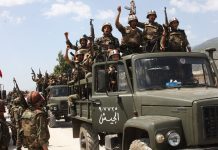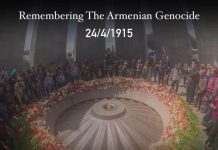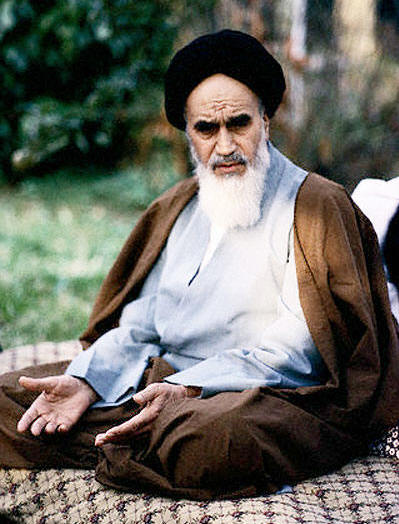آن الأوان لدفن شبح الخميني
أمير طاهري/الشرق الأوسط/19 آب/16
بعد مرور أكثر من 17 عاًما على وفاة آية الله روح الله الخميني٬ الرجل الذي قاد الملالي إلى السلطة في إيران٬ فإنه لا يزال محور الأحاديث والنقاشات خلال حقبة ما بعد الثورة التي قسمت صفوف الإيرانيين لدرجة دفعت البعض للتحريض على العنف ضد البعض الآخر.
الأسبوع الماضي٬ وصل النقاش حول العقد الذي قضاه الخميني في السلطة إلى مستوى جديد من الاحتدام مع نشر تسجيل سري يضم تعليقات أطلقها أقرب مساعدي الخميني إليه٬ الذي وقع عليه الاختيار ليخلفه٬ الراحل آية الله حسين علي منتظري٬ عام 1988.
وجاء نشر الشريط من جانب أحمد٬ نجل منتظري الباقي على قيد الحياة٬ يرافقه ادعاء بأنه جرى تسجيله في أغسطس (آب) 1988 أثناء اجتماع بين والده ووفد من الملالي جرى إرسالهم لطلب الإذن بتنفيذ الآلاف من عمليات الإعدام السريعة في غضون يومين.
وقد اتسم هذا الاجتماع بخلفية دراماتيكية٬ حيث كان الخميني قد قبل لتوه اتفاق وقف إطلاق نار مع العراق٬ لينهي حرًبا استمرت ثماني سنوات٬ من دون إنجاز هدفه المعلن المتمثل في الذهاب إلى «القدس عبر بغداد».
وكانت الحرب قد حصدت أرواح أكثر من مليون شخص٬ ثلثاهم تقريًبا من الإيرانيين من دون أن يتمكن «جيش الإمام» من التقدم ولو لمسافة بوصة واحدة.
في الواقع٬ عندما أعلن الخميني استسلامه غير المشروط في أغسطس ٬1988 كانت قوات صدام حسين تحتل جزًءا من الأراضي الإيرانية في زاينال كوش – Zaynal Kosh التي استعادتها إيران لاحًقا عندما أسقط الأميركيون الطاغية العراقي.
بمعنى آخر٬ فإن الخميني انتهى إلى الفشل بعد حربه المطولة التي تسببت في دمار خمسة أقاليم إيرانية٬ ووقوع آلاف الإيرانيين٬ غالبيتهم من المراهقين الإيرانيين٬ في الأسر وتداعي اقتصاد البلاد.
ولا بد وأن آية الله قد جفاه النوم ليالي طويلة بحًثا عن سبيل لتغيير الخطاب المتعلق بالحرب بعيًدا عن كونها هزيمة مخزية. وكما كان الحال دوًما٬ تفتق ذهنه عن حله المفضل: قتل أعداد كبيرة من الناس لتشتيت الانتباه بعيًدا عن إخفاقات نظامه المفتقر لأبسط معاني الإنسانية.
وتبًعا لدراسة أجرتها زينب منصوري٬ فإنه على الأقل 10 إيرانيين أو عراقيين ماتوا خلال كل ساعة من حكم الخميني. وقد أشرنا بالفعل إلى الأرواح التي زهقت هباًء على امتداد 8 سنوات من الحرب. إلا أن الخميني لم يكتف بذلك٬ وأقدم على قتل الآلاف في مذبحة مروعة للأكراد في نقده وكذلك تركمان في كنبد. ومن بين من قتلوا آلاف المتظاهرين٬ بينهم الكثير من النساء والأطفال٬ ممن خرجوا إلى الشوارع ليعلنوا رفضهم حكمه الشيطاني.
وبعد أن ألغى فعلًيا حكم القانون من البلاد٬ أنشأ الخميني محاكمه الثورية الإسلامية مع اضطلاع ملا واحد بدور القاضي٬ عادة ما كان من الطلاب الدينيين ولا يتجاوز العشرينات من العمر٬ ومن دون وجود تمثيل قانوني للمتهم٬ ولا شهود ودراسة للأدلة.
وتبًعا لتقديرات صادرة عن منظمة العفو الدولية وجماعات حقوقية أخرى٬ فإن ما يزيد على 100 ألف إيراني جرى إعدامهم خلال فترة حكم الخميني البالغة 10 سنوات. في المقابل نجد أن فترة حكم الشاه الراحل التي امتدت إلى 37 عاًما شهدت إعدام 317 شخًصا فقط٬ تبًعا لتقرير أصدره آية الله الراحل مهدوي كني الذي عمل رئيًسا للوزراء لفترة وجيزة خلال حكم الخميني.
في ظل حكم الخميني٬ شهدت إيران حماًما من الدماء وسيلاً من أعمال العنف لم يسبق لها معايشتهما منذ العصور الوسطى. وفي ظل هذه الخلفية٬ أمر الخميني عام 1988 بسلسلة إعدامات جماعية. وارتبطت غالبية الإعدامات بأفراد جماعة «مجاهدين خلق» التي ساعدت الخميني في الوصول إلى السلطة٬ لكن انفصلت عنه بعد 18 شهًرا.
واللافت أن غالبية من أعدموا كانت قد صدرت بحقهم أحكام بالسجن٬ ولم يكن هناك أي أساس قانوني٬ حتى في إطار نظام الخميني٬ لإعدامهم. (هناك تقارير متضاربة حول أعداد من أعدموا٬ وتتراوح التقديرات بين ألفين و4 آلاف) وفي إطار التسجيل الصوتي المعلن عنه الأسبوع الماضي٬ أبدى منتظري معارضته الشديدة لعمليات الإعدام ونصح بالتريث. وحذر من أن الإعدامات ستجعل الناس يتذكرون الخميني كـ«سفاح»٬ وأنها ستضر بصورة الثورة٬ بل والإسلام نفسه. وللتأكيد على وجهة نظره٬ كتب ولي العهد الفعلي رسالة إلى الخميني يحثه خلالها على إعادة النظر بالأمر.
أما «المرشد الأعلى»٬ الذي كان المتملقون قد رفعوا مرتبته في ذلك الوقت ليصبح «إماًما»٬ فاستجاب للخطاب بإصدار أوامره بتجريد منتظري من جميع مناصبه٬ بما في ذلك خلافة الحكم ووضعه قيد الإقامة الجبرية. ونسي الخميني أنه كثيًرا ما كان يصف منتظري٬ الذي كان أحد تلاميذه قبل ذلك بثلاثة عقود٬» قرة عيني» و«ثمرة حياتي».
بيد أنه ما ينبغي التنويه به هنا أن موقف منتظري في ذلك الوقت لم يكن نابًعا من مشاعر ليبرالية من جانبه.
في الواقع٬ على مدار تسع سنوات٬ صدق منتظري على الآلاف من أحكام الإعدام غير القانونية. إلا أنه بحلول عام ٬1988 كانت علاقته بالخميني قد تدهورت بسبب إصدار الأول أمًرا بإعدام شقيق زوج ابنته هادي هاشمي وإلقاء القبض على مجموعة كبيرة من المقربين منه في أعقاب تكشف فضيحة «إيران غيت» بين عامي 1985 و1987.
وعليه٬ فإن التسجيل الصوتي لا يجعل من منتظري قديًسا٬ وإنما يسلط الضوء على ضرورة أن تعيد النظر في حقبة الخميني على أمل الانطلاق في عملية متعقلة وهادئة لنزع الصبغة الخمينية عن البلاد.
المؤكد أن الخميني لم يقترف هذه الجرائم بمفرده٬ وإنما لا يزال الكثيرون ممن التقوا منتظري خلال هذا الاجتماع الشهير على قيد الحياة وفي مراكز نافذة بالبلاد.
وعلى مدار سنوات كثيرة٬ أطلق المعلقون تكهنات حول ما سيكون غورباتشوف إيران٬ مع طرح الكثيرين اسم الرئيس السابق محمد خاتمي٬ ليحل محله الآن الرئيس الحالي حسن روحاني. إلا أن آخرين تطلعوا باتجاه التجربة الصينية٬ بدلاً عن تجربة الاتحاد السوفياتي٬ في محاولة للبحث عن دينغ شياو بينغ الإيراني٬ في الوقت الذي حاول الرئيس السابق هاشمي رفسنجاني تقديم نفسه في هذا الدور.
بيد أنه قبل أن يمكن باستطاعة إيران أن يكون لديها غورباتشوف أو دينغ٬ يتحتم عليها أولاً العثور على خروشوف أو شو إن لاي. يذكر أنه أثناء كلمة ألقاها عام 1956 أمام المؤتمر الـ20 للحزب الشيوعي للاتحاد السوفياتي٬ فضح خروشوف جرائم ستالين٬ وسعى لإعادة تأهيل بعض ضحايا الستالينية وقاد الاتحاد السوفياتي نحو نمط من الحكم الاستبدادي يلتزم على الأقل بإطاعة قوانينه. وقد حدث الأمر ذاته في الصين فيما يخص إرث ماو تسي تونغ٬ بدًءا من عام 1971.
ومن دون التخلص من الصبغة الخمينية٬ لن يكون أمام الجمهورية الإسلامية بإيران أدنى فرصة لتحقيق الاستقرار السياسي والاقتصادي والقانوني المأمول.
Iran Needs to Bury Khomeini’s Ghost
Amir Taheri/Asharq Al Awsat/August 19/16
More than 17 years after his death, the man who led the mullahs to power in Iran, Ayatollah Ruhallah Khomeini, is still at the center of the post-revolution debate that has divided Iranians to the point of inciting some to violence against each other.
Last week the debate over Khomeini’s decade in power reached a new flash-point with the publication of the secret recording of remarks made in 1988 by the ayatollah’s closest aide, and designated heir at the time, the late Ayatollah Hossein-Ali Montazeri.
The audio-file was made public by Ahmad, Montazeri’s surviving son, with the claim that it had been recorded in August 1988 during a meeting between his father and a delegation of mullahs sent to seek permission to carry out thousands of summary executions within a couple of days.
The background to the fateful meeting was dramatic. Khomeini had just accepted a ceasefire with Iraq, ending an eight-year war, without achieving his declared aim of going to “Jerusalem via Baghdad.”
The war had claimed over a million lives, at least two-thirds of them Iranians, without the “Army of the Imam” making a single inch of conquest. In fact, in August 1988 when Khomeini announced his unconditional surrender, Saddam Hussein’s troops occupied a chunk of Iranian territory in Zaynal-Kosh which was later recovered by Iran when the Americans toppled the Iraqi despot.
In other words, Khomeini had ended up with egg on his face by prolonging a war at the end of which five Iranian provinces were in ruins, thousands of Iranian troops, mostly teenagers, were captured as war prisoners or were missing in action, and the nation’s economy was in meltdown mode with nothing positive to show for the folly.
The ayatollah must have spent sleepless nights seeking a way to change the narrative of a humiliating climb-down. As always, he came up with his favorite solution: killing large numbers of people to divert attention from the failures of his inhuman regime.
According to a study by Zaynab Mansouri, at least 10 Iranians or Iraqis died for every single hour of Khomeini’s rule. We have already noted the lives claimed by the senseless 8-year war. But Khomeini also killed thousands in the notorious massacre of Kurds in Naqadeh and the slaughter of Turkomans in Gonbad. He also killed thousands of demonstrators, including many women and children, who defied his satanic rule in the streets.
Having practically abolished the rule of law in the country, Khomeini had set up his Islamic Revolutionary Tribunals with a single mullah as judge, often clerical students in their twenties, and with no legal representation for the accused, no witnesses and no cross-examination of the evidence.
According to estimates by Amnesty International and other human rights groups over 100,000 Iranians were executed during Khomeini’s 10-year rule.
This compares to 317 executions during the late Shah’s 37-year reign, according to a report established by the late Ayatollah Muhammad-Reza Mahdawi Kani who briefly served as Khomeini’s Prime Minister.
Under Khomeini Iran suffered the kind of mass bloodshed and violence it had not experienced since the medieval times. It was against such a background that Khomeini ordered the mass executions of 1988. These mostly concerned members of an Islamist group, Mujahidin-e-Khalq (Combatants of the People), who had helped Khomeini come to power, but broke with him after 18 months.
Most of those executed had been sentenced to prison and there was no legal basis, even in Khomeini’s system, for their execution. (There are conflicting reports on the numbers involved, between 2000 and 4000.)
In the audio-file made public last week, Montazeri opposes the executions and advises caution. He warns that were the executions to be carried out Khomeini would be remembered as “a blood-sucker” (saffah) and that the revolution, indeed Islam itself, would be harmed. To nail in his point, the heir-apparent even wrote a letter to Khomeini begging him to be merciful.
The “Supreme Guide” who had promoted himself to the position of “Imam” with the help of sycophants, reacted by ordering Montazeri to be divested of all his positions, including that of successor, and put under house arrest. Khomeini simply forgot that he had repeatedly called Montazeri, who had been his student three decades earlier, “the pupil of my eye” and “fruit of my life.”
Montazeri’s position at the time was not dictated by liberal sentiments on his part. In fact, for nine years he had endorsed thousands of other illegal executions. By 1988, however, he had become sore with Khomeini because the ayatollah had ordered the execution of a brother of his son-in-law Hadi Hashemi and the mass arrest of people close to him in the wake of the Irangate scandal in 1985-87.
The “secret” audio-file does not transform Montazeri into a choirboy. Nor does it sweeten the image of those massacred by Khomeini. It does, however, highlight the necessity for Iran to re-examine the blood-soaked Khomeini era in the hope of embarking on a rational, calm and non-revanchist process of de-Khomeinization.
To be sure, Khomeini wasn’t alone in his crimes. Many of the men who met Montazeri are still alive and in positions of power.
Over the years, many commentators have speculated on who would be Iran’s Gorbachev, with former President Muhammad Khatami cast in that role for a while and which is now played by President Hassan Rouhani. Others, looking to China’s experience rather than that of the Soviet Union, have tried to find the Iranian Deng Xiaoping with former President Hashemi Rafsanjani trying to cast himself in that role. However, before Iran can have either a Gorbachev or a Deng, it must first find either a Khrushchev or a Chou En-lai.
In 1956, addressing the 20th Congress of the Communist Party of the Soviet Union, Nikita Seregyvich Khrushchev exposed Stalin’s crimes, rehabilitated some of the victims of Stalinism, and led the USSR towards a totalitarianism which obeyed at least its own laws. The same happened with de-Maoization in China thanks to Chou En-lai and Deng Xiaoping, starting in 1971.
Without serious de-Khomeinization, the Islamic Republic in Iran would have no chance of achieving a reasonable measure of political, economic and legal stability. De-Khomeinization would not transform a bad regime into a good one, far from it. But it might make it bearable for at least those within it.
Unless Iran definitely breaks with the lawlessness that Khomeini introduced, it won’t be able to tackle any of its numerous problems in a serious way. Without de-Khomeinziation no one will ever be safe in Iran, not even the current “Supreme Guide” Ali Khamenei. Maybe especially not him!
***Amir Taheri was the executive editor-in-chief of the daily Kayhan in Iran from 1972 to 1979. He has worked at or written for innumerable publications, published eleven books, and has been a columnist for Asharq Al-Awsat since 1987. Mr. Taheri has won several prizes for his journalism, and in 2012 was named International Journalist of the Year by the British Society of Editors and the Foreign Press Association in the annual British Media Awards.






















